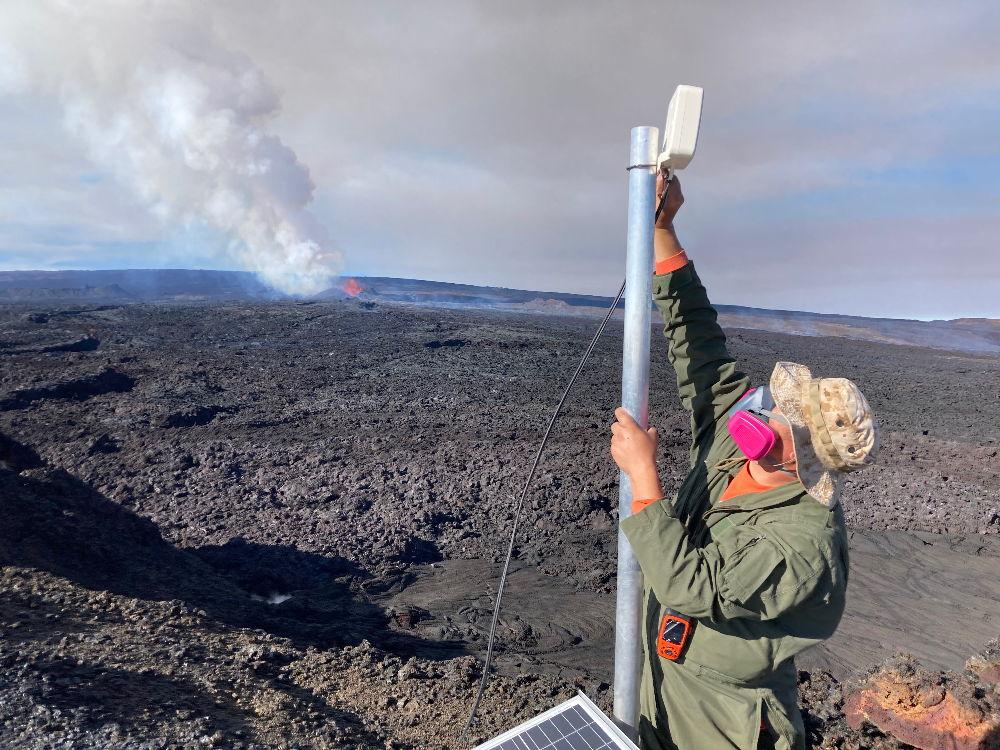
USGS: “An HVO scientist installs a webcamera to monitor the Northeast Rift Zone eruption of Mauna Loa. The livestream is available here.” (USGS image by M. Patrick)
(BIVN) – The USGS Hawaiian Volcano Observatory has launched another webcam to track the volcanic activity at Mauna Loa, and this time its full video livetreaming to YouTube.
The live video shows lava erupting from fissure 3 on the Northeast Rift Zone of Mauna Loa. The camera is located east of fissure 3 and looks west, the USGS says.
“The webcams are operational 24/7 and faithfully record the dark of night if there are no sources of incandescence or other lights,” a disclaimer to the USGS video stated. “Thermal webcams record heat rather than light and get better views through volcanic gas. At times, clouds and rain obscure visibility. The cameras are subject to sporadic breakdown, and may not be repaired immediately. Some cameras are observing an area that is off-limits to the general public because of significant volcanic hazards.”
According to today’s update from the USGS:
The Northeast Rift Zone eruption of Mauna Loa continues, with little change over the past 24 hours. One active fissure, fissure 3, is feeding a lava flow downslope. Fissures 1, 2, and 4 are no longer active.
Fissure 3 is generating a lava flow traveling to the north toward the Daniel K. Inouye Highway (Saddle Road) that has reached relatively flatter ground and slowed down significantly over the past several days, as expected. As of 7:00 a.m. this morning, December 3, the flow front was about 2.5 mi (4 km) from the Daniel K. Inouye Highway (Saddle Road). During the past 24 hours, the lava flow advanced at an average rate of about 40 feet per hour (13 meters per hour). Though the advance rate has slowed over the past 24 hours, the lava flow remains active.
Fissure 4 is no longer active; HVO geologists observed only glowing cracks in the area of fissure 4 during the eruption monitoring overflight this morning.
Advance rates may be highly variable over the coming days and weeks. On the flat ground between Mauna Loa and Mauna Kea, lava flows advance more slowly, spread out, and inflate. Individual lobes may advance quickly, and then stall. Additional breakouts may occur if lava channels get blocked upslope. There are many variables at play and both the direction and timing of flow advances are expected to change over periods of hours to days, making it difficult to estimate when or if the flow will impact Daniel K. Inouye Highway.
Sulfur dioxide (SO2) emission rates of approximately 180,000 tonnes per day (t/d) were measured on December 1, 2022, and remain elevated. Volcanic gas plumes are lofting high and vertically into the atmosphere before being blown to the west at high altitude, generating vog in areas downwind. Vog information can be found at here.
Pele’s hair (strands of volcanic glass) fragments are being wafted great distances and have been reported as far Laupāhoehoe.
Tremor (a signal associated with subsurface fluid movement) continues beneath the currently active fissures. This indicates that magma is still being supplied to the fissure, and activity is likely to continue as long as we see this signal.
There is no active lava within Moku’āweoweo caldera nor the Southwest Rift Zone. We do not expect any eruptive activity outside the Northeast Rift Zone.

by Big Island Video News2:32 pm
on at
STORY SUMMARY
HAWAII - A new livestream showing the lava eruption at Fissure 3 on Mauna Loa's Northeast Rift Zone has been posted on YouTube by the USGS Hawaiian Volcano Observatory.